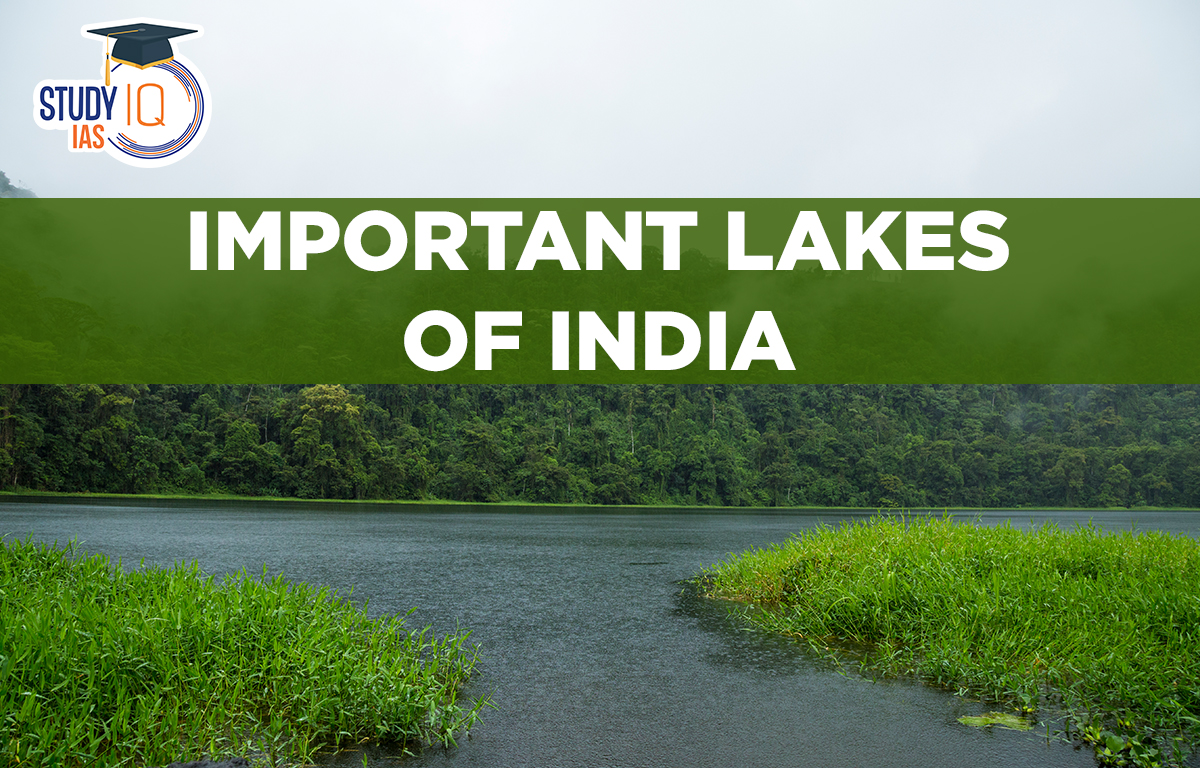A lake is a large body of water, which can be either fresh or salty, completely surrounded by land. Lakes can be formed naturally through geological processes or created by humans. India has many different lakes, like the big and beautiful Dal Lake in Kashmir and the small, Pushkar Lake in Rajasthan. They provide resources for drinking water, irrigation, and recreation, and they also hold cultural and historical significance for communities. They are also popular tourist spots with amazing views and fun activities.
Lakes of India
A lake is a large body of water that is deeper and bigger than a pond and it is surrounded by land, lakes do not have tides and do not flow like rivers. Most lakes have fresh water, but some are created by people to hold water for farming, industries, or homes. In very dry places, lakes can become salty if the water evaporates quickly leaving behind salt. These salty lakes are called “salt lakes” like Sambhar Lake.
| S.No |
Category of Lake in India |
| 1. |
Freshwater Lakes |
| 2. |
Saltwater Lakes |
| 3. |
Natural Lakes |
| 4. |
Oxbow Lakes |
| 5. |
Artificial Lakes |
| 6. |
Crater Lakes |
List of Important Lakes in India
We have discussed the Important Lakes in India, given below with the names along with the Location and Types:-
| Lake |
Location |
Type |
| Kolleru Lake |
Andhra Pradesh |
Natural Freshwater |
| Sambhar Lake |
Rajasthan |
Saline |
| Dhebar Lake |
Rajasthan |
Artificial Freshwater |
| Pushkar Lake |
Rajasthan |
Artificial Freshwater |
| Pichola Lake |
Rajasthan |
Artificial Freshwater |
| Rangsagar Lake |
Rajasthan |
Artificial Lake |
| Gobind Sagar Lake |
Himachal Pradesh |
Freshwater |
| Gobind Ballabh Pant Sagar (Largest Artificial Lake in India) |
Sonebhadra district, Uttar Pradesh |
Artificial Lake |
| Kanwar Lake |
Bihar |
Natural Freshwater |
| Ashtamudi Lake |
Kerala |
Freshwater |
| Paravur Lake |
Kerala |
Freshwater |
| Sasthamkotta Lake |
Kerala |
Freshwater |
| Bhojtal Lake |
Madhya Pradesh |
Artificial Freshwater |
| Veeranam Lake |
Tamil Nadu |
Artificial Freshwater |
| Chembarambakkam Lake |
Tamil Nadu |
Artificial lake |
| Vaitarna Lake |
Maharashtra |
Artificial Freshwater |
| Lonar Lake |
Maharashtra |
Freshwater |
| Vihar Lake |
Maharashtra |
Natural Freshwater |
| Dal Lake |
Jammu and Kashmir |
Natural Freshwater |
| Dipor Bil Lake |
Assam |
Natural Freshwater |
| Hussain Sagar |
Telangana |
Artificial lake |
| Shamirpet Lake |
Telangana |
Artificial lake |
| Sukhna lake |
Chandigarh |
Artificial Freshwater |
| Tsomgo Lake |
Sikkim |
Freshwater (Glacial) Lake |
| Nainital Lake |
Uttrakhand |
Natural Freshwater |
| Bhimtal Lake |
Uttrakhand |
Natural Freshwater |
| Dodital |
Uttrakhand |
Freshwater Lake |
| Senchal Lake |
West Bengal |
Artificial Lake |
| Belasagar Lake |
Uttar Pradesh |
Artificial lake |
| Kanjia Lake |
Odisha |
Natural Lake |
| Kanjli Wetland |
Punjab |
Freshwater Lake |
List of Major Lakes in Union Territories
| Lake Name |
Union Territory |
| Anchar Lake |
Jammu and Kashmir |
| Mansar Lake |
Jammu and Kashmir |
| Dal Lake |
Jammu and Kashmir |
| Wular Lake |
Jammu and Kashmir |
| Bharatpur Lake |
Andaman and Nicobar Islands |
| Mahatma Gandhi Marine National Park Lakes |
Andaman and Nicobar Islands |
| Chilika Lake |
Puducherry |
| Ousteri Lake |
Puducherry |
Top Five Largest Lakes of India
1. Vembanad Lake: Longest Lake in India and the Largest Lake in Kerala
| Overview |
| Location |
Kerala |
| Type |
Brackish and Freshwater |
| Square Area |
2033 square km |
| Depth |
12 m |
- This lake can be found in three separate state districts.
- This lake borders Kumarakom, a well-known tourist resort.
- This lake is famous for backwater houseboats, birdwatching, photography, and other activities.
- In the main body of the lake, the renowned snake boat race and Nehru Trophy boat race are held.
- Many migratory birds can be seen in and around this lake if one visits in the winter.
2. Chilika Lake: Largest Brakish water Lagoon in India
| Overview |
| Location |
Odisha |
| Type |
Brackish |
| Square Area |
1165 square km |
| Depth |
4.2 m |
- This largest coastal lagoon in the nation and the second largest in the world was formed by about 52 streams.
- The largest wintering ground for migratory birds and the largest nesting site for Olive Ridley Turtles
- This lake serves 132 communities and more as a fishing resource.
- The main attraction of the lake is Nalaban Island, which is a bird sanctuary.
- There are other islands such as Parikud, Bacon, Breakfast, Honeymoon, and Birds’ Island.
3. Shivaji Sagar Lake
| Overview |
| Location |
Maharashtra |
| Type |
Artificial and freshwater |
| Square Area |
891.7 square km |
| Depth |
80 m |
- Shivsagar Lake is an artificial freshwater lake in India, it is a reservoir in the state of Maharastra.
- The Lake formed after the Koyna River was impounded by the Koyna Dam.
- It has a Length of 50 Km and a depth of 80 m
- Shiv Sagar Lake is in Guhagar, Ratnagiri district, Maharashtra, India.
- The lake is surrounded by green areas and is a favorite spot for nature lovers and tourists.
- For those looking for a picnic location, the lake offers a beautiful view.
4. Indira Sagar Lake
| Overview |
| Location |
Madhya Pradesh |
| Type |
Artificial and freshwater |
| Square Area |
627 square km |
- Indira Sagar Lake located in the Khandwa district of Madhya Pradesh, India, is an artificial reservoir created by the Indira Sagar Dam.
- This lake was primarily built for irrigation, hydroelectric power generation, and flood control.
- The Indira Sagar Dam is a significant source of hydroelectric power for the region.
- It provides essential water for agriculture and drinking, contributing to regional development.
5. Pangong Lake
| Overview |
| Location |
Ladakh |
| Type |
Saline |
| Square Area |
700 square km |
| Depth |
100 m |
- This lake connects China and India. China occupies more than 60% of the lake.
- This lake freezes during the harshest winters.
- Thus, the best time is between May and September.
- The lake’s shores are a state stereotype for camping areas.
- Many birds that are migrating can be seen.
- Based on where the sun is in the sky, the lake’s colour varies throughout the day.
Famous Lakes in India
Kolleru Lake – Andhra Pradesh
- India’s largest lake is situated between the Krishna and Godavari deltas.
- Under the Ramsar treaty, it was designated a wetland of international significance in 2002.
Sambhar Lake – Rajasthan
- The largest inland salt lake in India is Sambhar Lake in Rajasthan.
- It produces 8% salt of total salt production in India
- The Sambhar Lake is mentioned in the Mahabharata as being a component of the demon king Brishparva’s realm.
- Pachbhadra and Didwana are the other salt lakes in Rajasthan.
Pushkar Lake – Rajasthan
- Found in the Rajasthani district of Ajmer’s Pushkar town.
- Hindus revere Pushkar Lake as a sacred body of water.
- During the Kartika Poornima holiday in November, thousands of pilgrims visit to take a dip in the lake.
Lonar Lake- Maharashtra
- Lonar Lake is situated in the Buldhana district of Maharastra.
- After a meteorite struck Earth 50000 years ago, the Lonar Lake was created. It is called a crater lake.
- Lonar Lake’s colour changed to pink overnight recently, Some experts speculate that the pink hue may result from the presence of algae and a low water level.
Pulicat Lake- Andhra Pradesh
- It is the second-largest brackish-water lake or lagoon in India lies in the border of Andhra Pradesh and Tamil Nadu
- The Satish Dhawan Space Center, where India’s first successful lunar space mission, the Chandrayaan-1, was launched, is located on the island.
Loktak Lake -Manipur
- North-East India’s largest freshwater lake
- KeibulLamjao, the only floating national park in the world and the final remaining habitat of the critically endangered sangai or Manipur brow-antlered deer floats above it.
- The Ramsar Convention named it a wetland of world importance in 1990.
Sasthamcotta Lake – Kerala
- Kerala’s largest freshwater lake.
- The existence of a sizable population of cavaborus larva, which eats germs in the lake water, is responsible for the lake’s water’s purity for drinking..
Vembanad Lake -Kerala
- The longest lake in India and the largest lake in the state of Kerala.
- The Nehru Trophy Boat Race is conducted in a portion of the lake.
Chilka Lake -Odisha
- Chilika Lake is the largest wintering habitat for migrating birds on the Indian subcontinent.
- It is a brackish water coastal lake. It is the largest coastal lagoon in India and the second-largest lagoon in the world.
Dal Lake – Jammu Kashmir
- The Dal Lake also referred to as “Srinagar’s Jewel,” is a lake in Srinagar that is essential to tourism.
- On the shores of Dal Lake is the biggest tulip garden in Asia.
- On the shores of Dal Lake lie the NishatBagh, Shalimar Bagh, and Mughal Gardens.
- The world’s only floating post office is located in Dal Lake
Nalsarover Lake- Gujarat
- In 1969, Nalsarovar Lake and the marshes nearby were designated as a bird sanctuary.
Tsomgo Lake – Sikkim
- Sikkim’s Tsongmo Lake, also known as Changu Lake, is a glacier lake.
- Located at an elevation of 3753m the lake remains frozen during the winter season.
- The lake serves as the setting for the Guru Purnima festival, during which Jhakris from Sikkim congregate there to take advantage of the lake’s therapeutic properties.
Bhimtal Lake – Uttarakhand
- It is the largest lake in the Kumaon region, which is referred to as India’s “lake district.”
- The lake has a “C” form.
Barapani Lake- Meghalaya
- Shillong is home to Barapani or Umiam Lake, which was created in 1965 as a result of the UmiamUmtru Hydro Electric Power Plant, the first hybrid power project in India’s northeast.
Nainital Lake – Uttarakhand
- Located in the Nainital region, which is also known as India’s Lake District, the lakes are kidney- or crescent-shaped.
Periyar Lake -Kerala
- Periyar Wildlife Sanctuary, a famous elephant reserve and tiger reserve, is situated on the banks of Periyar Lake.
- Periyar Lake was created in 1895 by building a dam across the Mullaperiyar River.
Hussain Sagar Lake – Telengana
- Hazrat Hussain Shah Wali constructed the lake in Hyderabad in 1562, during the reign of Ibrahim QuliQutub Shah.
- Links Hyderabad and Secunderabad, two twin cities.
- The 16-meter-tall, 350-ton monolithic Buddha statue atop the “Rock of Gibraltar” placed in the middle of the lake is a main draw at Hussain Sagar..
Salim Ali Lake – Maharashtra
- It has been renamed in honour of Salim Ali, a famous naturalist and ornithologist who is also referred to as the birdman of India.
- The Salim Ali Sarovar (lake), often referred to as Salim Ali Talab, is situated in Aurangabad close to Delhi Gate and across from HimayatBagh.
Kanwar Lake- Bihar
- The largest freshwater oxbow lake in Asia is the KanwarTaal or KabarTaal Lake.
Nakki Lake – Rajasthan
- The Indian hill town of Mount Abu in the Aravalli range is home to Nakki Lake.
- On February 12, 1948, Mahatma Gandhi’s ashes were scattered into this sacred lake, and Gandhi Ghat was built to honor him.
Bhojtar Lake- Madhya Pradesh
- The largest artificial lake in Asia is sometimes referred to as Upper Lake.
- It is located on the western outskirts of Bhopal, the state capital of Madhya Pradesh.
Wular Lake – Jammu Kashmir
- The Jhelum River feeds India’s largest freshwater lake, Lake Basin, which was created by geological activity.
- It is an ox-bow lake
- Tulbul Project is situated on it
- Largest freshwater lake in India.
Ashtamudi Lake
- Ashtamudi Lake is located in the Kollam district of Kerala, India.
- The name “Ashtamudi” means “eight coned” in Malayalam, referring to its shape and the eight distinct channels or arms extending from the lake.
- Ashtamudi Lake is part of the backwater system of Kerala and is known for its rich biodiversity, including various species of fish, birds, and plants.
Pulicat Lake
- The second-largest brackish water lake on the Coromandel Coast is Pulicat Lake.
- It is located on the border of Tamil Nadu and Andhra Pradesh.
- The lake and the Bay of Bengal are divided by the barrier island of Sriharikota
Salt Water Lakes of India
Sambhar Lake Rajasthan
- Sambhar Lake is India’s largest inland salt lake.
- It is bowl-shaped and surrounds the historic town of Sambhar Lake Town. This town is located on National Highway 8 in Rajasthan, 64 kilometres north of Ajmer and 96 kilometres south of Jaipur.
Artificial Lakes of India
Bhojtal Lake
- The largest artificial lake in Asia, Bhojtal, known as “Upper Lake,” is situated in Bhopal, Madhya Pradesh.
- It is an important source of drinking water for the residents of the city.
Gobind Sagar Lake
- Gobind Sagar Lake is a reservoir located in the Una and Bilaspur districts of Himachal Pradesh.
- It was created by the Bhakra Dam, which is one of the highest gravity dams in the world.
- The lake is named after Guru Gobind Singh, the eleventh Sikh guru, and is situated on the Sutlej River.
Jaisamand Lake
- Dhebar Lake also known as Jaisamand Lake is the second-largest man-made freshwater lake in India and the country’s first historical lake.
- It is located in the Udaipur District of Rajasthan.
Hussain Sagar Lake
- Ibrahim Quli Qutb Shah created the heart-shaped Hussain Sagar Lake near Hyderabad, Telangana in 1563.
- In 1563, Ibrahim Quli Qutb Shah built Hussain Sagar to span a Musi River stream.
- Hussain Shah Wali, the Kingdom’s Master of Architecture, was honoured with a lake name.
Chembarambakkam Lake
- Chembarambakkam Lake is located about 25 kilometers from the center of Chennai, Tamil Nadu, India.
- Along with Puzhal Lake, it is one of the two rain-fed reservoirs that supply water to Chennai City.
Natural Lakes of India
| Natural Lakes of India |
Location |
| Kolleru Lake |
Andhra Pradesh |
| Sambhar Lake |
Rajasthan |
| Pushkar Lake |
Rajasthan |
| Wular lake |
Jammu and Kashmir |
| Pulicat Lake |
Andhra Pradesh-Tamil Nadu state border |
| Loktak Lake |
Manipur |
| Chilka Lake |
Odisha |
| Dal Lake |
Srinagar, Kashmir |
| Sasthamkotta Lake |
Kerala |
| Vembanad Lake |
Kerala |
| Nalsarovar Lake |
Gujarat |
| Salim Ali Lake |
Delhi |
| Kanwar Lake |
Bihar |
Importance of Lake in India
- Lakes are very useful to people because they are popular tourist spots and offer fun activities like boating and water sports.
- Lakes also help manage water flow during dry seasons and heavy rains, preventing floods.
- Lakes can be used to generate hydropower.
- They also support the environment by preserving aquatic life, enhancing natural beauty, and boosting tourism and recreation. Saltwater lakes can also produce salt.
Important Facts related to Lakes of India
| Facts |
Name of the Lake |
| Deepest lake in the world |
Baikal (fresh water) in Russia |
| Largest fresh water lake |
Lake Superior, between Canada and the USA |
| Largest lake in the world |
Caspian Sea, bounded by Iran, Russia, Kazakhstan, Azerbaijan and Turkmenistan |
| Saltiest lake in the world |
Dead Sea bounded by Israel, Jordan and West Bank |
| Lowest lake in the world |
Dead Sea between Israel and Jordan |
| Largest lake in India |
Sambhar lake in Rajasthan |
| Largest fresh-water lake in India |
Kolleru lake in Andhra Pradesh |
| Largest coastal lagoon in India |
Chilka lake in Orissa |
| Sriharikota island is located in |
Pulicat lake in Andhra Pradesh |
| Land of lakes in india |
Udaipur, Rajasthan |
| Country known as land of thousand lakes |
Finland |
Sharing is caring!


 Places in News for UPSC 2025 for Prelims...
Places in News for UPSC 2025 for Prelims...
 Evaporative Demand: Main Drivers and its...
Evaporative Demand: Main Drivers and its...
 Indus Valley Civilization, History, Phas...
Indus Valley Civilization, History, Phas...





















